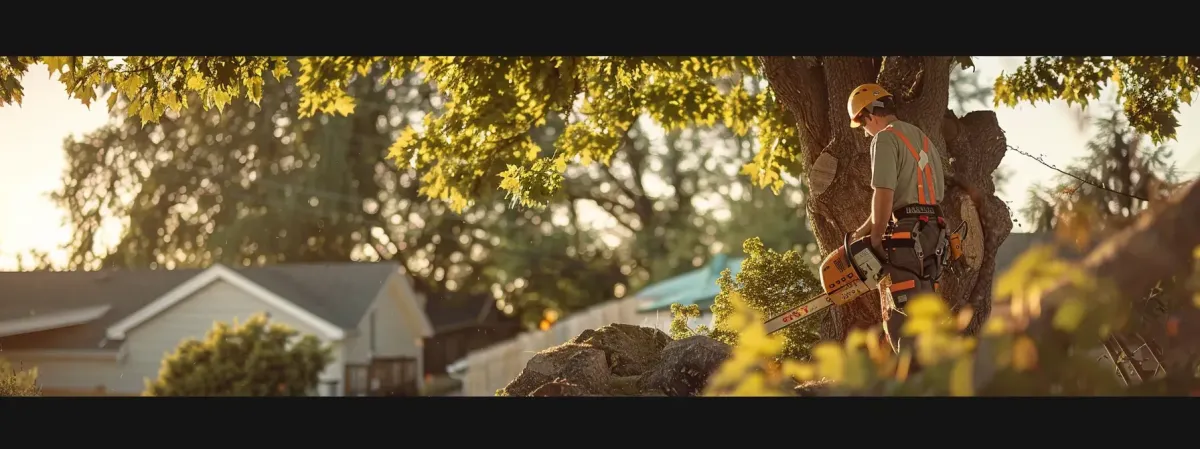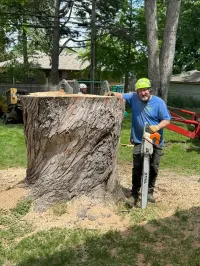Welcome to our Blog
The New Horizons Tree Experts Blog

How to Safely Remove Tree Limbs: A Step-by-Step Guide for Homeowners
Have you ever faced the challenge of unsafe tree limb removal? This blog post shows homeowners how to safely remove tree limbs with clear, step-by-step instructions. It outlines key steps from assessing the situation, using proper safety gear, and applying correct cutting methods to managing cleanup. Readers will benefit from practical tips that reduce risks and save time, making tree limb removal a more controlled task.
Assess the Situation Before Starting Tree Limb Removal

Examine tree limbs needing attention and check for nearby obstructions like power lines in the yard. Evaluate physical ability and available tools while identifying invasive species and risk factors. Determine if certified arborists or stump grinding services are required to assess the overall health of the limb tree for safe removal.
Identify Problem Tree Limbs Requiring Attention
Homeowners should inspect tree limbs critically, paying attention to those that appear damaged or unhealthy, for instance, diseased oak branches that may risk falling. Experts in tree services advise that proper tree pruning can prevent further decay and reduce the chance of debris ending up in a landfill, while careful evaluation ensures each tree limb receives the necessary attention for safe removal.
Check for Power Lines and Other Obstructions Nearby
When inspecting the area for removal, experts advise verifying nearby power lines and physical obstructions that may impact safety, including underground soil variations that could affect equipment stability. Professionals recommend engaging emergency service contacts if issues arise, and they note that improper tree limb disposal of wood can sometimes spread disease. The assessment serves to help homeowners minimize risks and ensure all hazards are addressed effectively before commencing the removal process.
Evaluate Your Physical Ability and Available Tools
Homeowners must assess their physical condition and verify that the available equipment, from hedge trimmers to saws, suits the demands of the removal process. They should also consider the option of professional tree removal services to guarantee customer satisfaction and mitigate debris, ensuring that the mulched waste is safely managed afterward.
Determine if the Limb Tree Task Needs Professional Assistance
Homeowners should consider professional help if the task surpasses their skills or if they must handle heavy branches while avoiding hazards like nearby power lines, ensuring safe removal of shrub limbs, excess leaf matter, and brush waste. Equipped with the right rope and caution, an expert can efficiently manage the removal process, reducing potential injuries and preventing further damage.
Inspect the Overall Health of the Limb Tree
The inspection begins by evaluating the overall tree health using an experienced approach to tree care. Experts note that assessing the extent of storm damage and recognizing early signs of decay can help manage yard waste and prevent further complications, while consulting tree care services recommended by Civicplus can offer additional guidance to ensure safe limb removal.
Gather Your Safety Gear and Proper Cutting Tools

Homeowners should select appropriate PPE and choose the correct saw type for the trunk and limbs during tree removal. Ensure ladders or lifts are stable, keep first-aid supplies accessible, and maintain sharp blades for efficient pruning. Tree care proper precautions to align with expert tree service procedures throughout the process.
Select Appropriate Personal Protective Equipment (PPE)
Homeowners must wear certified gear such as helmets, goggles, and gloves to reduce injury risks during tree limb removal. The use of quality personal protective equipment sets the stage for safe work and helps prevent accidents when handling sharp cutting tools and heavy branches. Proper PPE selection ensures that both amateurs and experienced individuals work with added confidence and improved safety outcomes.
Choose the Correct Saw Type for the Limb Size
Homeowners should select a saw that matches the branch diameter to ensure efficient cutting and improved safety during tree limb removal. A chainsaw suits thicker branches while a hand saw may work better for smaller limbs, allowing proper handling and reducing the risk of common injuries.
Ensure Ladders or Lifts Are Stable and Positioned Safely
Ensuring that ladders or lifts are placed on a firm, even surface is vital for a secure working environment during tree limb removal. Professionals advise checking all equipment for proper support, which helps reduce the risk of accidents when homeowners reach higher areas or access hard-to-reach branches. Stability and correct positioning also promote a smoother workflow and boost overall safety measures during tree limb removal tasks.
Keep First-Aid Supplies Accessible During Work
Homeowners should keep a designated first-aid kit at hand while removing tree limbs to address unexpected injuries quickly and maintain a secure work environment. This proactive measure helps ensure that essential medical supplies, such as bandages and antiseptics, are readily available to minimize disruptions during the task, reinforcing overall safety throughout the process.
Maintain Sharp Blades on Your Cutting Tools
Homeowners must verify that blades on cutting tools remain sharp during tree limb removal to ensure efficient cuts and reduce the risk of injuries. Professionals note that regular maintenance of saws and scissors extends their lifespan and enables precise work on various branch sizes. This simple measure supports a safe and effective process while complementing overall safety gear and proper cutting tool selection.
Prepare the Work Zone for Safe Limb Removal Operations

Homeowners must prepare the work zone by clearing the area below each limb, setting a safe perimeter free of people and pets, planning an escape path before cutting, and notifying household members or neighbors. This establishes a secure environment for tree limb removal and prepares for the detailed steps that follow.
Clear the Ground Area Directly Below the Tree Limb
Homeowners should clear the ground area by removing debris and obstacles to ensure a safe working environment for tree removal. This approach minimizes the risk of injuries from falling limbs or tools, allowing landscapers and homeowners to conduct the operation with confidence and ease. Additionally, proper tree care is essential for maintaining a healthy landscape.
Establish a Secure Perimeter Free of People and Pets
Homeowners secure the work area by marking a clear boundary to keep individuals and animals safely away from active removal zones. This practice minimizes distractions and potential hazards, allowing professionals to work with confidence. Ensuring such isolation supports a systematic approach to tree limb removal and reduces potential risks during maintenance activities.
Plan a Clear Path for Retreat Before Making Cuts
Homeowners must map out an exit route before initiating any cutting to ensure a safe retreat when tree limbs shift unexpectedly. Clear ground visibility and robust planning reduce potential mishaps during tree operations, leading to a more controlled and secure removal process. This preemptive strategy helps professionals and DIY enthusiasts alike avoid injuries and achieve successful tree care.
Inform Household Members or Neighbors About the Work
Homeowners should alert household members and neighbors before starting tree limb removal to ensure everyone is aware of potential safety risks. This proactive communication aids in maintaining a secure work zone and minimizes unexpected interference from those nearby.
Apply Proper Cutting Methods for Tree Limbs

This section details proper cutting steps for safe tree limb removal. It explains making an initial undercut, performing a relief cut farther from the trunk, and completing a final cut near the branch collar. It also covers measures to prevent bark tearing and safely manage the fall of large, heavy limbs.
Make the Initial Undercut on the Limb's Underside
Homeowners should make the initial cut on the limb's underside to establish a controlled breakpoint, allowing for a safer removal process. This technique minimizes the chance of unintentional cracking and supports the overall structure during tree limb removal while aligning with recommended safety practices.
Perform the Relief Cut Further Out From the Trunk
Homeowners should perform the relief cut further out from the trunk to prevent splintering and maintain control when removing tree limbs. This step helps ensure that the limb falls safely, reducing potential hazards and aligning with expert recommendations for effective tree pruning and limb disposal.
Complete the Final Cut Close to the Branch Collar
Professionals advise that making the final cut close to the branch collar preserves the tree's natural defense, ensuring a clean heal during the waiting period. This technique, employing a well-maintained saw and firm control, reduces the risk of damaging adjacent limbs and enhances the safety and efficiency of tree limb removal. Homeowners benefit from this approach by preventing unnecessary decay and maintaining optimal tree health.
Prevent Bark Tearing During the Tree Limb Removal Process
Experts recommend using sharp, well-maintained tools and controlled, deliberate cuts to minimize the risk of bark tearing during tree limb removal. This approach helps maintain clean edges and reduces structural stress on the tree, promoting a healthier, quicker recovery while also ensuring safe and efficient removal practices.
Manage the Fall of Large or Heavy Tree Limbs With Care
Homeowners must prepare a secure area and maintain constant control when managing the fall of large tree limbs. Professionals advise using a controlled release technique by ensuring a clear landing zone and employing proper cutting methods, which significantly reduces the risk of injury and property damage during removal. This approach ensures that even heavy limbs are managed safely and efficiently for a smoother cleanup operation.
Manage Post-Removal Cleanup and Limb Disposal Effectively

The process continues with breaking removed tree limbs into smaller pieces, confirming local yard waste rules, and using a wood chipper for smoother disposal. Experts also urge examining the tree for any damage after cutting and tidying the work area to maintain a safe, efficient space for ongoing maintenance.
Section Removed Tree Limbs Into Smaller Pieces
Homeowners should cut larger branches into manageable segments using reliable tools to simplify disposal and adhere to local yard waste rules. This step not only eases the cleanup process but also minimizes physical strain during subsequent sorting and recycling operations. Professional experience shows that segmenting removed limbs can lead to more efficient property restoration after tree limb removal.
Check Local Regulations for Yard Waste Collection
Homeowners should verify local regulations for yard waste collection before disposing of tree limbs to ensure compliance and avoid fines. Local authorities often provide guidelines on waste separation and designated pickup days, making adherence to these rules vital for a smooth disposal process. Expert landscapers advise staying informed about regional tree care management practices to improve cleanup efficiency and maintain neighborhood safety.
Consider Using a Wood Chipper for Removed Limbs
Homeowners can benefit from using a wood chipper to convert large tree limbs into smaller, manageable pieces for easier disposal and recycling. This equipment streamlines the cleanup process and helps ensure compliance with local yard waste regulations while reducing manual labor. Expert guidance confirms that employing a wood chipper results in a tidy, safer work environment and a more efficient post-removal operation.
Examine the Tree for Any Damage After Cutting Is Complete
After completing the cutting process, homeowners should inspect the tree for any signs of stress or decay that may have been caused during limb removal. This careful evaluation allows for early detection of potential issues, ensuring that any damage can be addressed by qualified tree professionals to maintain long-term tree health. The assessment provides peace of mind and helps prevent future hazards by identifying areas that may need further attention.
Tidy the Work Area Thoroughly
Homeowners should dedicate time to clear away debris after tree limb removal, ensuring a clean and safe work area. This method helps prevent accidents and maintains an orderly yard, which supports future maintenance efforts and improves overall property appeal.
Recognize When Professional Tree Limb Removal Is the Safer Choice

Homeowners must assess if limbs are too large or high, show signs of disease or weakness, or lie near buildings or utilities. They should also recognize when available tools and experience fall short, making professional tree limb services necessary. Evaluating these factors helps in finding qualified arborists for safe and effective removal.
Handling Exceptionally Large or High Tree Limbs
Expert guidance is recommended when handling exceptionally large or high tree limbs, as their mass and height can render manual removal dangerous. Professionals in tree limb removal advise that using advanced equipment and certified techniques ensures customer safety, reducing the risk of injury and property damage while maintaining tree integrity during the cutting process.
Spotting Signs of Disease or Weakness in the Limb Tree
Experts note that visible discoloration, cracks, or unusual sap flow in tree limbs can signal underlying disease or structural weakness, suggesting a need for professional evaluation before removal. Recognizing these indicators early helps homeowners avoid hazardous conditions and ensures that specialized tree services manage the task safely and efficiently.
Removing Limbs Positioned Near Buildings or Utilities
Removing limbs near buildings or utilities requires specialized techniques and experienced professionals to ensure safety and prevent property damage. Homeowners who attempt these tasks without suitable equipment or expertise may face risks such as structural damage or hazardous contact with power lines, making the use of certified tree service experts a prudent decision.
Lacking the Necessary Equipment or Experience for the Job
Homeowners without the necessary equipment or skills face potential risks when attempting tree limb removal on their own; engaging certified tree service experts guarantees the use of specialized tools and proven techniques that protect property and personal safety during the removal process.
Finding Qualified Arborists for Safe Tree Limb Services
Homeowners seeking safe tree limb removal should rely on certified arborists with proven expertise in handling potentially hazardous branches. Qualified professionals ensure proper tools are used and adhere to strict safety practices, reducing risks and delivering consistent, effective service tailored to each property’s unique needs.
Conclusion
Homeowners gain confidence by preparing their work zones and using proper safety gear and cutting techniques. They improve tree health and reduce hazards by inspecting limbs, assessing potential risks, and planning each removal step thoroughly. Practical checks, including examining nearby obstructions and local regulations, empower users to take control of the process safely. Working with skilled experts remains a valuable option when tasks exceed personal skills or equipment capabilities.
Get A Quote
Click below or call for more info

Working Hours
Mon: 8am - 5pm
Tues: 8am - 5pm
Wed: 8am - 5pm
Thur: 8am - 5pm
Fri: 8am - 5pm
Sat: 8am - 5pm




